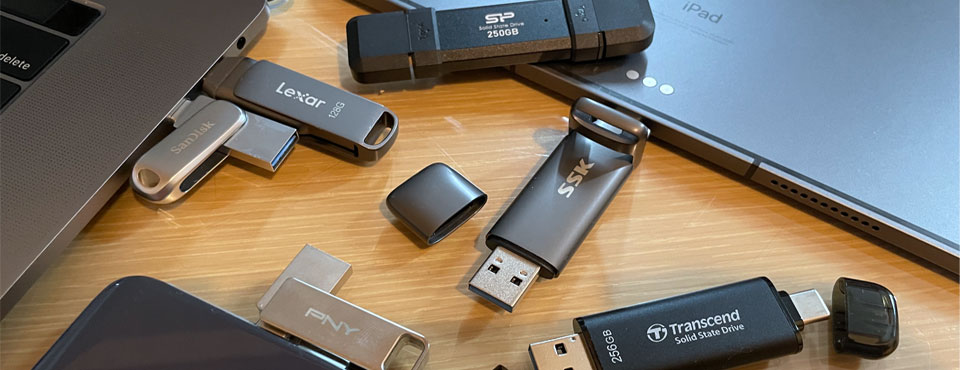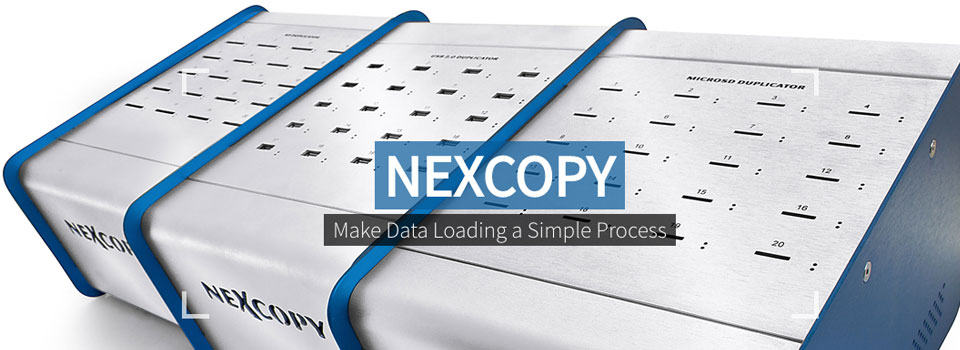We tested six dual flash drives from PNY, Sandisk, Silicon Power, SSK, TeamGroup, and Transcend. These drives serve as a bridge between USB-C and legacy USB-A ports. With both connectors available, there’s no need for multiple drives or adapters, making it easier to transfer files across devices of different platforms.
Contents
Our Pick
The Transcend ESD310 stands out as the best dual-headed flash drive we’ve tested on the market. Its speed is unmatched, breezing through our benchmarks effortlessly as the ESD310 is essentially a mid-range SSD in the form of a thumb drive. Additionally, it offers a generous five-year warranty and comes in three color options: black, silver, and pink.
Still, if you frequently shuttle huge files, edit 4K/8K footage, or need steady speeds for long transfers and backups, a traditional USB SSD is the safer bet thanks to its superior thermals and controllers that sustain performance under prolonged heavy loads.
What are Dual Flash Drives?
Dual flash drives – having USB Type-A and USB-C connectors on opposite ends – are becoming more relevant as more computers and smartphones ship with the reversible USB port exclusively. They make sure you have readily access to your data on your future-proof USB-C devices as well as giving you backward compatibility on PCs with good old USB Type-A. For this reason, it will never hurt to have at least one of these dual-headed flash drives in case you need a quick and easy file transfer solution.
Feature Comparison
 PNY Duo Link V3 $39.99 for 256GB |  Sandisk Ultra Dual Luxe $24.99 for 256GB | Silicon Power DS72 $45.99 for 250GB |  SSK Dual USB-C Drive $39.30 for 256GB |  TeamGroup X1 Max $35.99 for 256GB |  Transcend ESD310 $39.99 for 256GB |
|
| Storage: | 256GB - 2TB | 32GB - 1TB | 250GB - 2TB | 128GB - 2TB | 256GB - 2TB | 256GB - 2TB |
| Interface(s): | USB 3.2 Gen 2x1 (10Gbps) | USB 3.2 Gen 1 (5Gbps) | USB 3.2 Gen 2x1 (10Gbps) | USB 3.2 Gen 1 (5Gbps) | USB 3.2 Gen 2x1 (10Gbps) | USB 3.2 Gen 2x1 (10Gbps) |
| UASP? | Yes | No | Yes | Yes | Yes | Yes |
| Dimensions: | 79.5 × 18 × 10.4mm | 44.5 x 12.2 x 8.6mm | 81 x 21.3 x 10.4mm | 78 x 20.5 x 8.6mm | 63 x 20 x 8mm | 71.3 x 20 x 7.8mm |
| Weight: | 40g | 17g | 15.6g | 37g | 12g | 11g |
| Build Material: | Metal | Metal | Metal body & rubberized caps | Metal | Plastic body, plastic caps | Metal body, plastic caps |
| Keychain Loophole? | Yes | Yes | No | Yes | No | No |
| USB Plug Protection? | Rotating cap | Rotating cap | "Flip" caps | One removable cap and one rotating cap | Two removable caps on opposite ends | Two removable caps on opposite ends |
| Activity Light? | No | No | Yes | No | No | No |
| Color(s): | Black | Silver | Black | Gray | Black | Black, silver & pink |
| Android File Manager? | No | Sandisk Memory Zone | No | None | None | Transcend Elite data management |
| Release Date: | June 2025 | Oct 2023 | April 2024 | April 2023 | June 2024 | April 2023 |
| Warranty: | 2 years | 5 years | 5 years | 5 years | 5 years | 5 years |
| Country of Origin Label: | Made in Taiwan | Made in various countries, including China, Taiwan & Malaysia | Made in Taiwan | Made in China | Made in Taiwan | Made in Taiwan |
Pricing is last updated by Amazon on 2025-11-28 at 09:55. When you buy through Amazon affiliate links on our site, we may earn an affiliate commission.
Benchmark Analysis
We carried out our drive benchmarks on two different platforms – Windows 10 Pro running on MacBook Pro (2019) and iPadOS 17.6.1 running on Apple iPad Pro (2021). For our PC benchmark, our testing with the USB-C interface involved transferring a 9GB MP4 file back and forth between our MacBook Pro and the drives. We then repeated the process with a 5GB folder containing 1000 JPEGs. Tests were carried out on Nodesoft’s DiskBench.

Performance-wise, PNY Duo Link V3, Silicon Power DS72, TeamGroup X1 Max, and Transcend ESD310 are in a league of their own. The latter three use Silicon Motion’s SM2320 native USB flash controller – the same one found in Kingston’s DataTraveler Max and XS2000. Their use of an SSD-grade controller, fast NAND, and a USB 3.2 Gen 2 (10Gbps) interface puts them well ahead of previous‑generation flash drives, which are often limited to USB 3.2 Gen 1 (5Gbps) and simpler controller designs.
From the graph above, while the TeamGroup X1 Max hit 800MB/s mark in large file reads, Silicon Power DS72 and Transcend ESD310 were quite a bit faster in small file write operations – 341MB/s (Transcend) and 350MB/s (Silicon Power) versus 237MB/s (TeamGroup). PNY Duo Link V3 – recently added to the round-up – went head-to-head with Silicon Power DS72.
SSK Dual Drive is limited by its 5Gbps USB 3.2 Gen 1 interface; otherwise, it should perform a lot better. Lastly, SanDisk’s Ultra Dual Luxe, which has undergone a silent upgrade, showed a significant performance boost over the previous version. However, it still fell short of SSD-grade drives from PNY, Silicon Power, TeamGroup, and Transcend.
Since nearly all of the featured drives are SSDs, we also checked out their respective pseudo-SLC cache sizes and post-cache write speeds. Transcend ESD310 and SSK Dual Drive have allocated 70GB and 30GB as its pseudo-SLC cache respectively, while both TeamGroup X1 Max and PNY Duo Link V3 have approximately 25GB of cache. Silicon Power DS72 has the smallest cache among the group, with about 15GB available before the write performance fell off noticeably
According to our 45GB endurance tests on 256GB units, the post-cache write speeds varied noticeably among the drives. The Transcend ESD310 would drop from 580MB/s to 70MB/s, followed by the SSK Dual Drive, which fell from 350MB/s to 60MB/s. In comparison, write speeds of TeamGroup X1 Max, PNY Duo Link V3, and Silicon Power DS72 degraded to roughly 350 to 360MB/s after their caches ran out. These three models demonstrated a relatively balanced post-cache performance. That said, the Transcend ESD310’s large pseudo‑SLC cache — around 70GB — allowed it to maintain better write performance for a longer duration before the drop occurred, outpacing the rest of the group during large file transfers.
Next, we looked into the kind of performance you can expect if you plan on using these dual flash drives for regular photo backups and large video imports on an Apple iPad Pro. The 2021-model iPad Pro is equipped with USB-C capable of delivering 10Gbps through USB 3.2 Gen 2 and 40Gbps through USB4.
That said, Lexar JumpDrive D400, and Sandisk Ultra Dual Luxe, and SSK Dual Drive are limited to 5Gbps (USB 3.2 Gen 2 Gen 1). Silicon Power DS72, TeamGroup X1 Max and Transcend ESD310 in contrast connect at 10Gbps (USB 3.2 Gen 2). For this set of benchmarks, we repeated the same copying process with the same files we used on the MacBook Pro earlier.

Again, the Silicon Power DS72, TeamGroup X1 Max and Transcend ESD310 consistently outperformed other drives on our iPad Pro. Read and write performance across the board was significantly faster with these three, making them the clear choice for photo and video backup on smartphones and tablets with USB-C.
Beginning with iPadOS 15, a progress bar was introduced in iPadOS’ Files app to indicate the amount of data being copied and the remaining time needed for the file transfer to complete. Apple also has made significant improvements to USB drive performance on iPadOS, bringing it up to par with that of Windows. Before the much-needed overhaul, there was definitely something wrong with how Apple handled write operations on UFDs. It’s good to hear the issue has now been resolved.
Lastly, content creators might be interested to know that the Silicon Power DS72, TeamGroup X1 Max and Transcend ESD310 are fast enough for 4K Apple 10-bit ProRes recording on the iPhone 15 Pro Max. They also meet the iPhone’s maximum power draw requirement of 4.5W. At 4k, ProRes 422 HQ mode consumes about 12GB per minute at 60fps or 6GB per minute at 30fps. External storage is also necessary for 60fps recording, which requires drives with at least 220MB/s sequential write speed.
Drive Build & Design
Both the PNY Duo Link V3 and Sandisk Ultra Dual Luxe feature the same swiveling cap design and a durable all-metal body. The Duo Link V3, however, is more than double the size of the Ultra Dual Luxe. SSK Dual Drive has a flip cap for its USB-C connector and a removable cap for its USB-A connector on the opposite end.
The Silicon Power DS72 is fitted with TPU rubber flip caps for both connectors, but we had a feeling that the caps could fall off over time with frequent use. In comparison, TeamGroup X1 Max and Transcend ESD310 both come with two removable plastic caps for plug protection as well as preventing the drive’s sharp edges from puncturing jean pockets. The caps on these flash drives are easy to misplace if one isn’t careful.
All the featured drives come with a metal build helps dissipate heat effectively, but in the case of Sandisk, we had to wait half a minute or so before unplugging the drive as it can become too hot to handle after several minutes of intense I/O operations.
Lastly, on warranties: all tested drives — with the exception of the PNY Duo Link V3 — offer five years of coverage. Flash drives from reputable brands are generally reliable, but a longer warranty is always preferable if you intend to use the drive for years.
Recap
SSD-class dual-headed drives are steadily replacing slower “dumb” alternatives. The trade-off is size, since performance-focused models are typically larger for thermal management. Even so, the Transcend ESD310 strikes a compelling balance of price, portability, and performance.
That said, if you regularly work with very large files (e.g. 4K/8K media), or need sustained performance for long transfers and backups, you should still consider a “regular” USB SSD; their larger thermal headroom and controllers typically maintain higher, more consistent speeds under sustained loads.
Best Deals Online
Pricing is last updated by Amazon on 2025-11-28 at 09:55. When you buy through Amazon affiliate links on our site, we may earn an affiliate commission.









